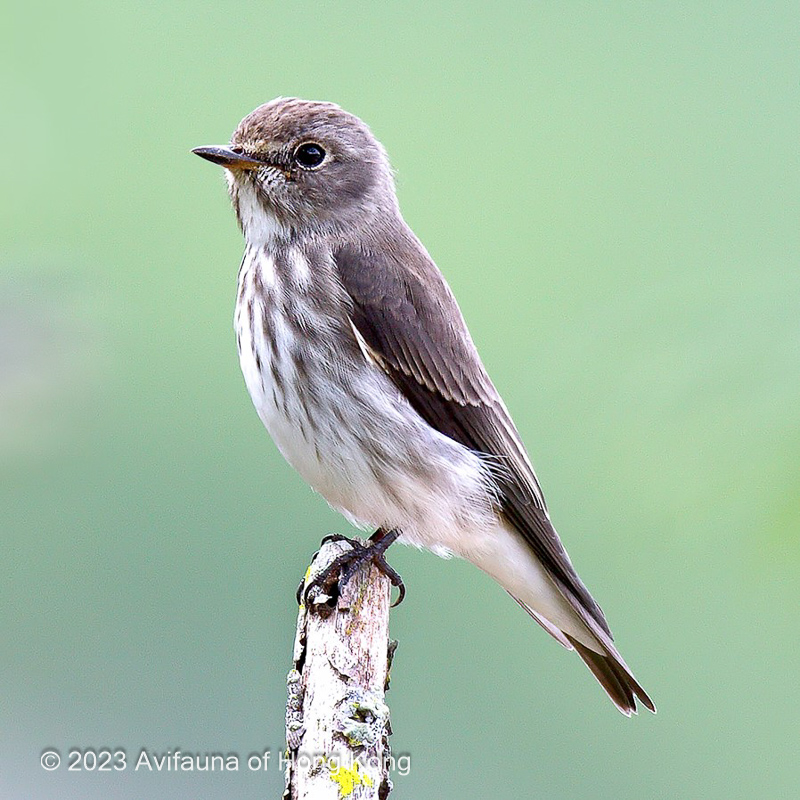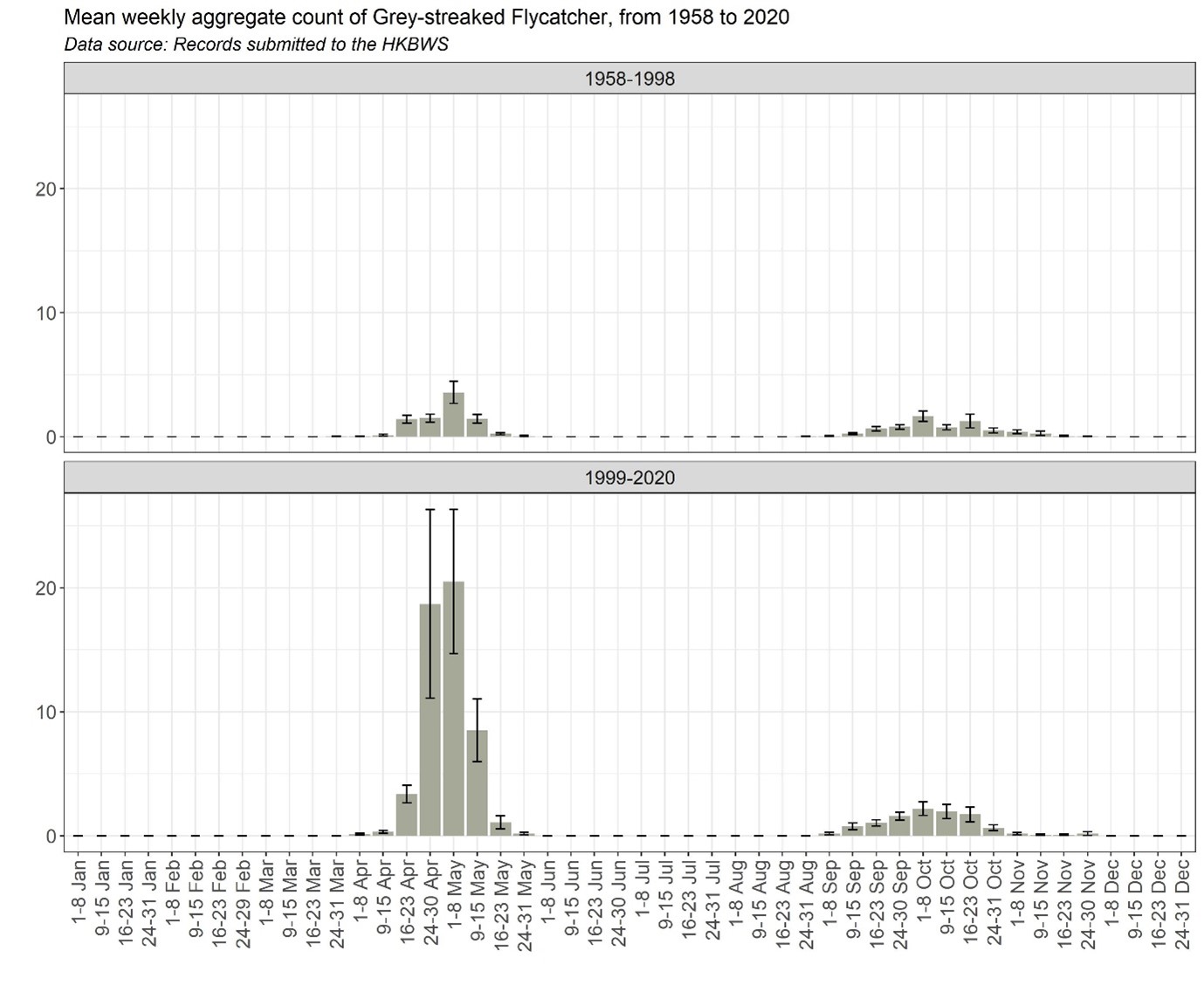Grey-streaked Flycatcher Muscicapa griseisticta 灰紋鶲
Category I. Uncommon passage migrant to lightly wooded areas in variable numbers, mostly in spring.
IDENTIFICATION

Oct. 2007, Michelle and Peter Wong.
12.5 – 14 cm. A small, long-winged grey flycatcher with prominent dark grey streaks on white underparts, and a long primary projection. Sexes alike. Head and upperparts are greyish-brown; it has a white submoustachial stripe, a greyish-brown malar stripe, a narrow whitish eye-ring, and diffuse pale lores. The wings and tail are dark brown. The underparts are white with distinct, dark grey streaks on the breast and flanks; the undertail coverts are white.

Oct. 2007, Michelle and Peter Wong.
First-winters on autumn passage have white tips to the greater coverts forming a distinct wing bar, and white-fringed tertials. A few (such as the one illustrated) retain juvenile feathers – usually a few white spots on the scapulars and uppertail coverts.
Distinguished from Asian Brown Flycatcher by darker lores and lateral throat stripe, streaked submoustachial, diffuse streaking on crown (sometimes) and dark, well-defined streaks against white underparts. Some Dark-sided Flycatchers have streaking on the underparts, but these are less well-defined than on Grey-streaked Flycatcher and may merge on the breast and flanks (Leader 2010).
VOCALISATIONS
The usual call is a high-pitched, downslurred ‘tseeee’.
DISTRIBUTION & HABITAT PREFERENCE
Widespread wherever open-canopy shrubland or woodland offers suitable cover. Noted regularly in wooded areas in the central New Territories, as well as in more open country such as Mai Po NR if trees are present. Frequent on offshore islands including Lantau, Lamma, Cheung Chau and Tung Ping Chau; it is particularly regular at Po Toi. Also reported from Ho Man Tin in urban Kowloon.
OCCURRENCE
Uncommon passage migrant in variable numbers, mostly in spring, to open-canopy shrubland and woodland. Extreme dates are 25 March and 27 May in spring, and 28 August and 29 November in autumn. More numerous in spring than autumn, with 85% of records between 1999 and 2020 occurring at this season (Figure 1). Up to the end of the 1990s only 56% of the records were in spring. High numbers are usually a result of the passage of the northeast monsoon or tropical storms.
March sightings are very rare and very few are recorded in the first half of April; numbers increase in the third week and peak passage occurs in the last week of April and the first week of May: 73% of all spring records occurred during this period during 1999-2020.
Many sightings are of single birds, and most peak counts are in single digits. However, larger numbers are occasionally noted, particularly during inclement weather. The highest spring count up to 1998 was 12 at Cheung Chau on 5 May 1989. Considerably higher counts have been made since: 50 were at Mai Po NR on 8 May 1999 in the aftermath of Typhoon Leo and, more recently, 65 were seen flying north in small groups at Fanling Golf Course on 24 April 2020 during a surge of the northeast monsoon; this is the highest count on record.
Autumn migration occurs mainly in September and October, with peak passage from the last week of September to the third week of October, although numbers are low. The highest recent autumn count involved eight at Po Toi on 1 October 2009 in the aftermath of a tropical storm, while the highest autumn count on record is ten at Shek Kong on 22 October 1978.
The estimated total number of individuals per year during 1999-2020 varied considerably from three to as high as 138 in 2013 and 191 in 2020. A general increase since 2008 is likely due to an increase in observer activity.
Grey-streaked Flycatcher was first recorded in Guangdong in October and May by Vaughan and Jones (1913). It was first reported in HK by Herklots (1941) who noted up to two at Pok Fu Lam on 7th and 8 May 1941. Herklots (1953) later stated that it was a passage migrant occurring in the first half of May and in the middle fortnight of September, with occasional records in October.
BEHAVIOUR, FORAGING & DIET
Usually, solitary. Forages from an exposed perch, often making rapid sallies to catch flying insects. May return to the same perch but does this less frequently than Dark-sided Flycatcher.
SYSTEMATICS & RANGE
Monotypic. Breeding summer visitor to northeast China (north Nei Mongol, Heilongjiang and Jilin), North Korea, southeast Russia, Sakhalin and the Kuril Islands; winters in Taiwan, Philippines, north Borneo, Sulawesi, east Lesser Sundas, Moluccas and west New Guinea. Occurs on passage through most of southeast China (Clement 2020).
CONSERVATION STATUS
IUCN: Least Concern. Population trend stable.
Figure 1.

Clement, P. (2020). Grey-streaked Flycatcher (Muscicapa griseisticta), version 1.0. In Birds of the World (J. del Hoyo, A. Elliott, J. Sargatal, D. A. Christie, and E. de Juana, Editors). Cornell Lab of Ornithology, Ithaca, NY, USA. https://doi.org/10.2173/bow.gysfly1.01
Herklots, G.A.C. (1941). Notes and comments. Ornithology. Hong Kong Naturalist 10: 137-147.
Herklots, G.A.C. (1953). Hong Kong Birds. South China Morning Post, Hong Kong.
Vaughan, R.E. and K.H. Jones (1913). The birds of Hong Kong, Macao and the West River or Si Kiang in South-East China, with special reference to their nidification and seasonal movements. Ibis 1913: 17-76, 163-201, 351-384.
Leader, P. J. (2010). Brown, Siberian and Grey-streaked Flycatchers: identification and ageing. British Birds 103: 658-671.
